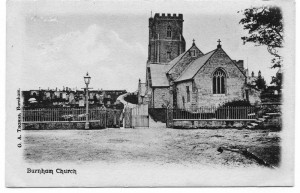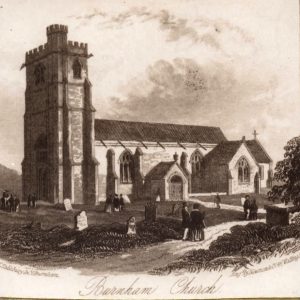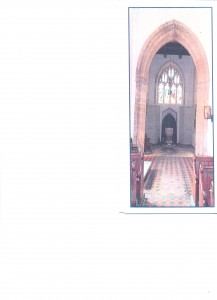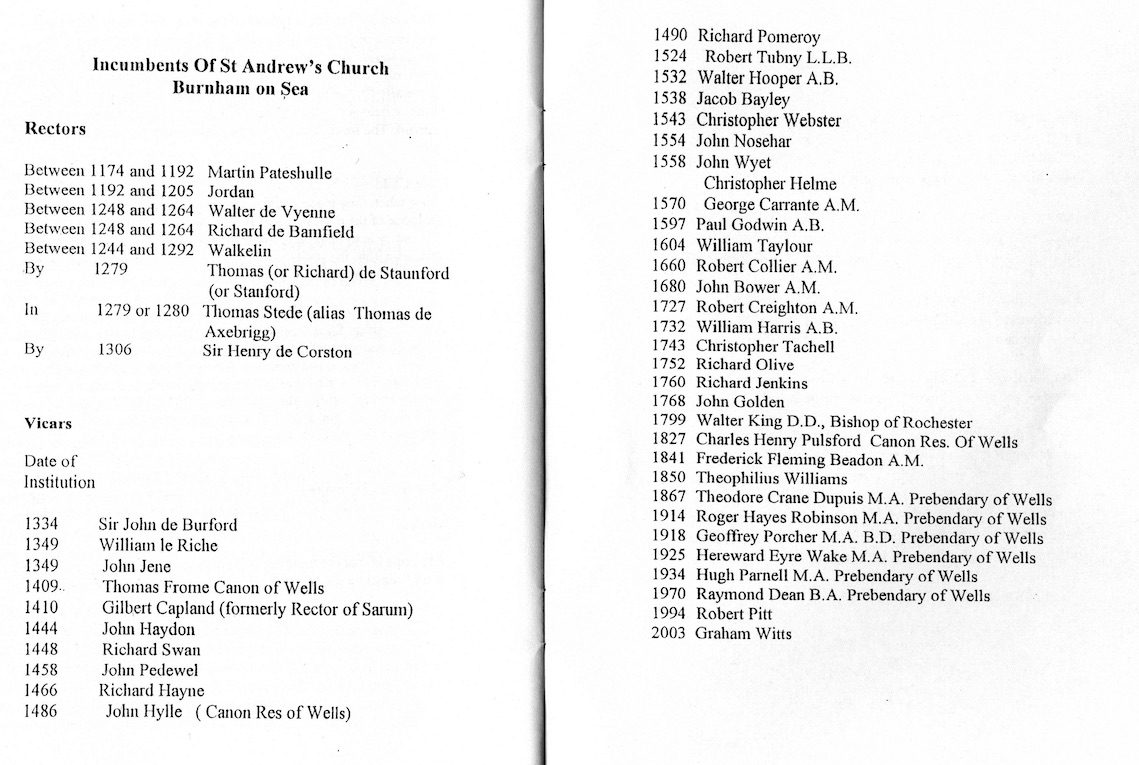
This is the Parish Church of Burnham-on-Sea. There was certainly a church in Burnham in 1100 and possibly back as far as the 9th century which may have stood on or very close to this site . The church we see now was first consecrated in 1314 and dedicated in 1315. The oak door at the entrance dates from 1315 and was originally in the inner doorway. The porch was built in the late 14th Century. Inside the arch on the left, there is a little scratch sundial – early 13th Century. On the right is a Holy water stoup and a consecration cross is halfway up the arch. A new sundial was fixed above the porch.
The main body of the Church was built in 1315 and two feet below the present floor is the rough earth floor of that Church. The chancel dates from 14th Century and was restored in 1878. The windows in the nave are 14th Century. The Aumbray (recess) on the North wall was discovered at the time of restoration in 1974. On the South wall in the West window are fragmented glass-work – typical of Somerset craftsmen in the late 15th Century.
The ceiling was added in the 17th Century. The brass chandelier dates from 1773 and was made in Bridgwater by Thomas Bayley. The chandelier, previously cleaned with Brasso, was lacquered in the late 20th Century.
There is some evidence that the church yard may have been used for playing the game of ‘Fives’ during the 18th century. This was a hand-ball game similar to the Basque game of pelote, played against a wall with buttresses, hence the use of the wall of a church tower. It was popular in this form in the West Country and accounts from elsewhere indicate that shutters were hung to protect the church windows. Sam Nash discovered an entry in the St Andrew’s Church accounts for 1769 of a payment “for making the Shut at the Fives Place”. Many considered it a desecration of the church yard and a public nuisance. A contemporary rhyme summarised this: “Whoever here on Sunday / Is found playing at ball / It may be before Monday / The devil will have them all.”
In 1790 Richard Locke criticised “….the rich farmers of Burnham for having destroyed one fourth of the old seats in the church and, where they stood, erected twelve pews about six foot square as private property without any faculty from the Bishop, consent of the vicar or churchwardens or even so much as an act of vestry. From all which pews the poor are totally excluded, and devotion hindered, the proprietors now mixing male and female being obliged to sit and wave the accustomed duty of kneeling at prayers. This spiritual innovation is the more grievous to be born as the church has but one nave, the large chancel, two small aisles and a belfry having lately been wainscotted to keep the farmers wives warm.”
The sculptures behind the Altar, in the Nave window and in the Baptistry – were commissioned by James II and formed part of an Altar Piece for the Chapel of Whitehall Palace – they were designed by Sir Christopher Wren and are the works of Arnold Quellin and Grinling Gibbons. They were taken from Whitehall to Westminster Abbey and by order of Queen Anne, placed behind the High Altar. The Dean and Chapter removed them about 1820 and the Bishop of Rochester, Dr. Walker King who was also the Vicar of Burnham for 27 years, obtained them for this Church.

Six bells were hung in 1823 and two more in 1902. The clock mechanism was installed in 1836 and Westminster Quarters fitted in 1904.
The North aisle and gallery were added in 1838 to meet the need of visitors to the Spa in Steart House (off the Esplanade). The population of Burnham and Highbridge in 1801 was 653 and by 1841 it was 1469. The present population is 20,000. The extra seating was provided by the Curate who built the first lighthouse and owned the Burnham Spa.
The organ (W G Vowles of Bristol) dates from 1885.
A large memorial on the South wall commemorates the Reed Family – George Reed had the Manor House, The Reed’s Arms Hotel, Catherine and Julia Terraces and the new National School built in Burnham. The pulpit is Jacobean with a modern sounding board – the wood has been repaired and painted many colours during the centuries. The present green painting in the Church was done in 1974.
Beneath the carpet before the step to the Chancel is a black stone with the inscription “Never to be removed”. Beneath this stone lies buried Richard Locke and his first wife. Richard Locke lived at Pillsmouth and owned the land on which Burnham Holiday Village was built. He was a wealthy landowner and he devised the system of rhynes draining the levels.
The Chapel beside the pulpit is dedicated to St. Nicholas and used daily for private prayer. A pre-reformation Altar Stone was rescued from the Churchyard in 1939 and is on the west wall. On the front of this stone are 5 crosses and on the back is inscribed “Sacred to the memory of William Harding who died August 2nd 1841 aged 63. Also Betsy, wife of the above who died October21st 1846 aged 65. Also Joseph Harding, who died August 29th 1834 aged 3 years. Also Rhoda Harding who died October 2nd 1853 aged 28 years”. Also in the Chapel are relics of a much earlier Church.
The stonework in the Nave was completely restored in 1974.
The wooden memorial bears the names of local men who lost their lives in the two World Wars and there are also mementoes of H.M.S. Burnham in the corner.a banner in the ship’s honour hangs in the Nave. The tower is late 14th Century. Settlement took place immediately and it has been leaning ever since.


Information from the church booklet ‘The Story of St Andrew’s Church’.
Follow this link for additional information.
This short film from the Norman Gobey collection filmed on 9.5mm in the 1930’s shows the church roof in a state of disrepair, a local fundraising drive helped to repair it.
Discover the next location on the trail: 21. The Old Vicarage

My name is Phillip Brent Arney from Perth western Australua
My younger brother who has his business located in London advised me of one of our great great Grandfathers our grandfather in Western Australia had a farm south of Perth in which he named the farm Brent Knowl
My father has a Anglican nursing home named in his honour called the Peter Arney nursing Home in Manning (3 Kilometers from Perth City )
as he was the Chairman of Anglican homes also our
mother was the first women ordained as a Anglican minister also my brother Mark Brent Arney is Anglican minister
I would like any further information you may have of my Great great Grandfather John Arney
Kind regards
Phillip Brent Arney
Presumably you have looked at ancestry.com, where there are many, many John Arney’s. Could you give me his date of birth and death, also his souse’s name and names of any children, so that I know which one to research.
Alan W